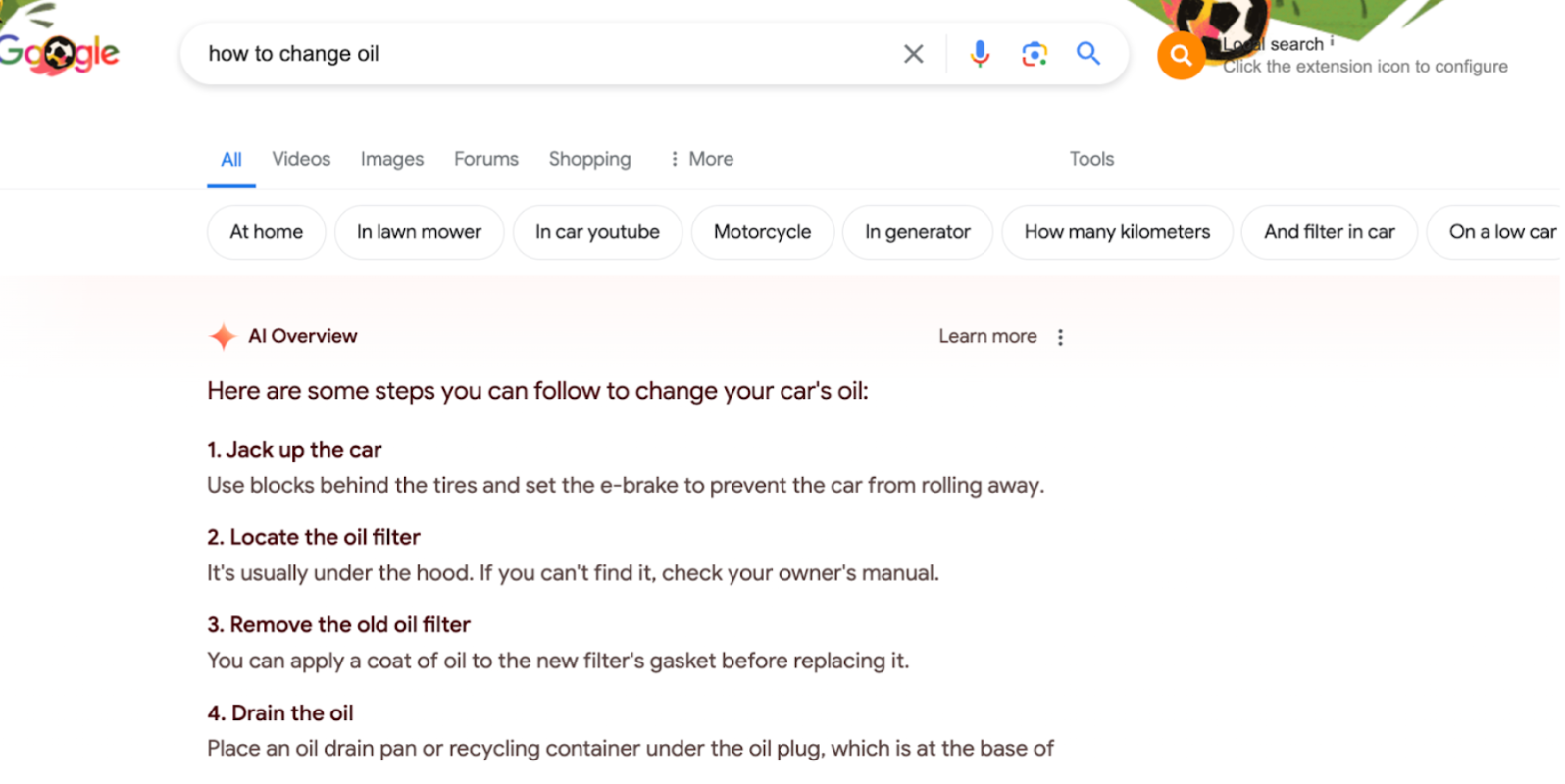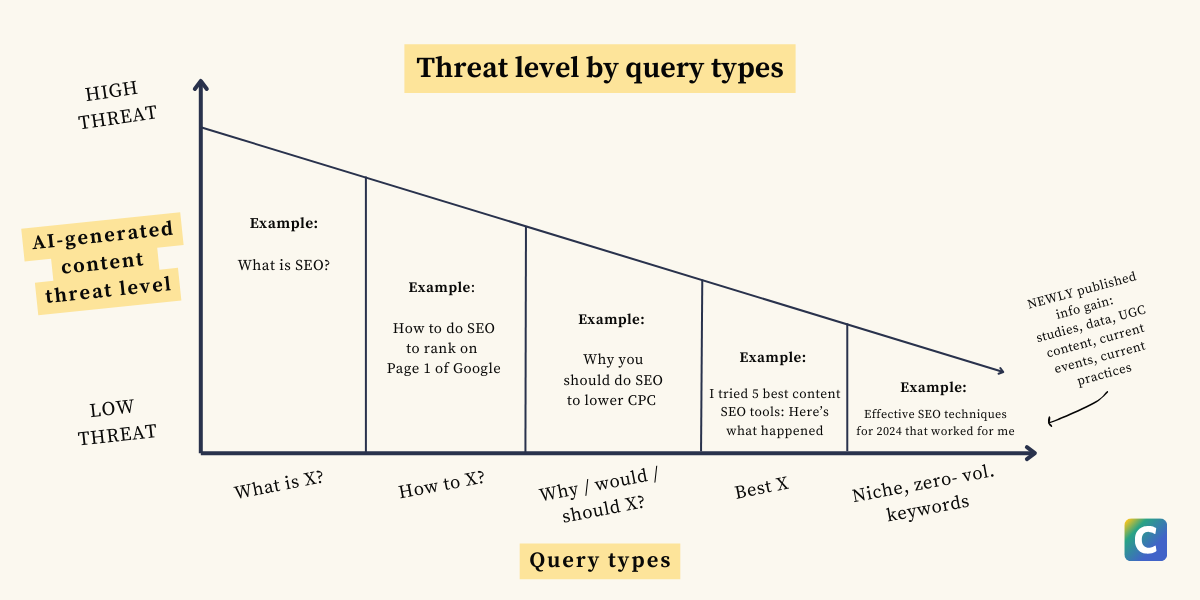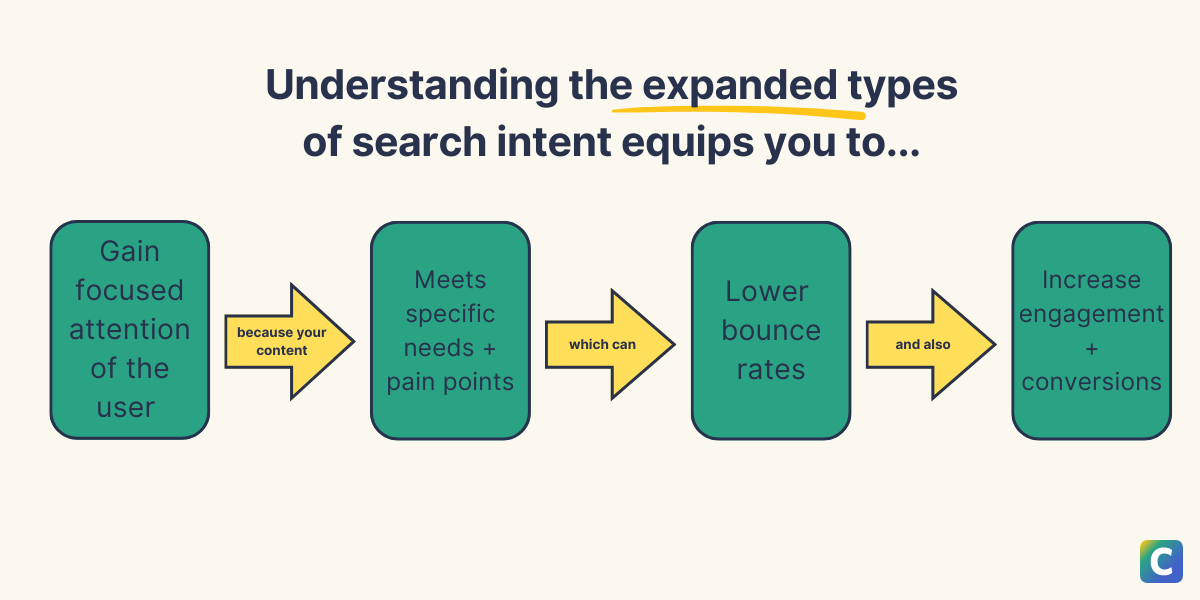Beyond the Basics: Exploring Expanded Types of Search Intent for SEO Mastery
Topic: SEO
Published:
Written by: Bernard Huang
The different types of search intent: Are there just 4?
SEO and content marketing pros have agreed upon four basic types of search intent:
Informational
Navigational
Commercial
Transactional
But doesn’t this feel a bit… limited?
If you’re a seasoned marketer who knows your target audience and ideal customer profiles (ICPs) as well as you know yourself, focusing on four basic buckets of search intent can limit your ability to truly optimize well.
Sure, they’re a good place to start. But so is elementary school.
As algorithms and SERP features rapidly change and SEO strategy follows, it’s time to graduate into a deeper understanding of the types of search intent.
In fact, a deep understanding of user intent is crucial to creating stand-out, high-quality converting content in the era of Google’s AI Overviews and AI-generated content in search.
(Plus, it’s just a good user experience practice that you should be applying across your organic marketing strategy.)
First, let’s look at the four basic types of search intent that most SEO professionals and content marketers agree upon. Then we’ll explore an expanded understanding of those intents.
LEARN MORE: Check out What is search intent for a deeper look at why your audience’s search intent is important.
4 basic types of search intent (with examples)
At a high-level, SEOs and content marketers can agree on the following types of search intent and definitions:
Informational intent
Navigational intent
Commercial intent
Transactional intent

Table shows the four different types of search intent with examples.
These are also the four basic types of search intent you’ll see in keyword research tools like Ahrefs and Semrush.
Traditional tools like these crawl the Google search engine results pages (SERPs) with their own crawlers and bucket keyword intents.
Below, I’ll walk you through examples of each of the four basic types—including how each of these search intent types play out in relation to Google’s AI Overviews.
Informational search intent
When a user goes to a search engine to learn about a given topic, they have informational intent.
People can search for information in the form of quick answers—such as [what year was basketball invented?]—or more in-depth guides, like [history of basketball] or [how to shoot a layup].
Other examples of informational queries include:
How to braid hair
What is turmeric?
Benefits of reading
Best metrics to track for social media growth
Why should people stretch?
Recipe for chocolate chip cookies
You can use several types of content to satisfy informational search keywords, such as how-to guides, videos, recipes or step-by-step tutorials, and long-form articles.
Informational queries and AI Overviews
In theory—and in observations across discussions in the SEO industry—general informational intent queries that are based on consensus have a higher chance of prompting an AI Overview answer in the search results. (source)
Think: Is this likely to bring up a featured snippet to end the user’s search journey immediately? If so, it’s likely an AI Overview could show for this particular query.
A few examples of these types of queries include:
How to change oil
How to screenshot on mac
What is user intent
What’s the capital of Maine?
Are brown recluse spiders in kansas?

Google SERP shows an AI Overview for [how to change oil].
For a smart content strategy in the AI era, this means that targeting search queries with more specific intent and from a perspective-driven, Ranch-style SEO approach would likely be more competitive.

Chart illustrates Generated AI content threat level by query types.
Navigational search intent
People use navigational queries on search engines to get to specific web pages or homepages, and they’re usually paired with specific brand names or organizations.
Examples of navigational searches include:
Amazon
AEP online bill pay
Target orders
Allbirds shoes
Instagram login
Apple store online
Google keyword planner
American airlines customer service
These search queries are navigational because the searcher has a particular destination in mind. The click-through rates on these keywords are often high, but navigational keywords aren’t necessarily smart to incorporate into your search engine optimization strategy.
Why? Well... that’s where understanding search intent is important. The user needs a specific website, and if your site isn’t it, pass on optimizing for these.
Navigational queries and AI Overviews
For now, it’s less likely that AI Overviews will impact navigational searches. (source)
Google's AI Overviews are currently geared toward informational searches, which indicates they're more likely to surface for queries aimed at understanding something quickly, rather than seeking out a particular website.
Transactional search intent
When a user goes to a search engine to complete an action, such as buying something, this is transactional search intent.
These are among the most valuable keywords to target in SEO since they often lead to a conversion of some kind (subscription or purchase).
And we all know that we love to see increased conversion rates, so targeting these specific keywords are an important part of your overall digital marketing strategy.
Examples of transactional queries include:
Buy headphones
Meal prep kit coupon
Laptop student discount
Exercise bike free shipping
HBO free trial
Nike air jordan blue and white
Transactional queries and AI Overviews
With transactional queries, it’s less likely an AI Overview will display because, in general, it wouldn’t be very helpful to a searcher. (source)
Many times, people are looking for specific products, brand names, or product names in Google search results.
AI Overviews are designed to give you quick summaries and guide you through topics you're interested in. When it comes to transactional searches, users are typically already set on what they want and are ready to make a purchase.
Commercial search intent
Commercial intent keywords also have to do with purchase decisions, but shoppers use them to research before buying. Specifically, a user may want to learn more about brands, products, or services.
Often, these queries have lower organic traffic estimates than their informational or navigational counterparts.
Examples of commercial search terms include:
Nikon vs. Canon
Adobe Photoshop
Best slow cookers
Smartphone reviews
Affordable running shoes
Best postpartum swimsuits
You can optimize content for commercial investigation by creating quality content that helps potential consumers discover the best deal for them. Examples include detailed product pages, competitor comparisons, and case studies.
Pro tip: Explore the People Also Ask questions for your target keywords for ideas.
Commercial queries and AI Overviews
Navigating Google's AI Overviews and their role in commercial search intent can be a tad more nuanced than the other intent types. While they may pop up occasionally, they're not regularly a part of AI Overview features just yet.
Google could sprinkle in features like product listings while keeping their focus on delivering primo content for users. (source)
The best thing to do? Test the search queries you’re targeting in Google to determine what SERP features pop up. Read more in How to analyze for search intent.
Okay, let’s move on to the next piece of this puzzle: Additional types of search intent.
Expanded types of search intent—there are more than just 4

This chart provides a quick look into the expanded types of search intent with examples. Below, we'll dig in to each one.
In her 2023 MozCon presentation, SEO leader Lily Ray acknowledged how SEOs often categorize search intents into three categories: transactional, navigational, and informational.
But Lily highlighted that the basic bucket approach to search intent isn’t all there is to this concept: “Let’s be real. There are way more than 3 intents in SEO.” (source: slides 63 and 64)
In addition to the widely acknowledged four basic intent types recognized by traditional SEO tools, there are what I like to call intent lenses.
More simply, these are just different intents that can live under the buckets of the four basic ones.
These seven additional types of search intent are basically the “expansion pack” to the Original Four:
Local search intent
Low-intent (or not likely to take action)
High-intent (or likely to take action)
News or current intent
Entertainment intent
Educational intent
Visual intent
Other SEOs and content strategists may have additional lenses they’d add to this list, but overall, intent lenses can dramatically inform search intent—and therefore, specific search results.
And that’s why it’s absolutely essential to have a granular understanding of the expanded search intents of your target audience and the content types that best meet these intents.
When you optimize your content with a sharp understanding of search intent, you’re better equipped to create content that:
Grabs focused attention of the user > because it >
Meets specific needs and pain points > which >
Lowers bounce rates > and >
Increases engagement and conversions

And therefore, a better understanding of the true varied types of search intent can produce better organic visibility, authority, and results for your brand’s content.
Let’s look at a few examples of each of these seven intent lenses below.
LEARN MORE: Why is search intent important? Read How to optimize search intent.
Local search intent
Users are looking for something in a specific geographical area through this expanded search intent lens.
Examples of local search queries include:
Gyms open now
Dinner reservations
Urgent care near me
Oil change service nearby
Gluten-free bakery in Charlottesville
Nearby library book dropoff
But there are a few subtypes of search intent that can fall under this category, too, including:
Visiting in person, like [best cafes in San Francisco]
Local information, like [plumber in Chicago]
Low and high search intent
People may describe keywords as having low intent or high intent. These terms refer to the relative level of purchase intent or intent to take action behind the keyword.
This search query intent closely ties the user to the likelihood they’ll take a next step in their search journey or continue to travel down a stereotypical sales funnel. However, this doesn’t necessarily mean informational intent vs. commercial intent.
For example, [weed legalization legislation ohio] has a lower actionable intent that the high-intent search query of [how to vote for weed legalization ohio], but neither are transactionally or commercially related.
News and current events search intent
This intent lens captures users looking for the latest news or updates on a particular topic.
Examples include:
Latest news on climate change
Britney Spears latest news
Current mortgage rates
Russo-Ukrainian War updates
Weather for today
Entertainment search intent
Here, users seeking entertaining content, such as videos, music, or games.
Examples include:
Funny cat videos
Top 10 movies 2024
Best board games similar to Catan
Lyrics to Beyonce's version of "Jolene"
Educational search intent
This is when users are looking for educational content or resources in their search topic.
Examples include:
Online courses for data science
Wine tasting workshops near me
Physics experiments for high school students
Public speaking tips for introverts
Visual search intent
Within this intent, people are looking for visual examples or videos to fulfill their need.
Examples include:
Hairstyle trends for short hair
Landscaping ideas for small gardens
Funny dog videos
Electric guitars stock photos
Red dresses with small white flowers and big sleeves
Next, let’s put all that learning together in a chart.
And not just any chart—a side-by-side comparison of the types of search intent with these lenses in mind for the beloved topic of [chocolate].

This table provides examples of the varied search intents within the target topic of [chocolate].
If you take a moment, you’ll notice that many of these queries meet multiple lenses of search intent.
But each of these individual queries require a unique approach to optimize the best piece of content to end the user’s search journey.
Some of these search intents could benefit from a long-form article, some a short-form landing page, and others might not benefit from creating content around at all. They might just require a well-optimized video or ecommerce product page.
Up next: How to analyze search intent
In wrapping up, it's clear that the traditional view of search intent is just the tip of the iceberg.
With the rise of Google's AI Overviews and shifting user preferences, we need to dive deeper into understanding the diverse intents driving search behavior—and they change over time.
By embracing expanded “intent lenses,” you can craft content strategies that truly resonate with your audience.
Now? Take this expanded view and apply it to analyzing search intent rev-up your content strategy.
Check out How to analyze search intent in the era of AI Overviews next.
How Chima Mmeje Uses Keyword Clustering To Generate Growth
Learn how content marketing manager Chima Mmeje uses keyword clustering to better organize and prioritize content efforts and generate explosive growth.
Read moreInformation Gain in SEO: The Guide to Convincing Yourself, Team, and Clients to Rethink Current Strategies
What is information gain? Why is everyone talking about it? This is the guide you need to persuade yourself, your team, and your clients to reassess your current strategy to include info gain in your content.
Read moreHow to Implement Ranch-Style SEO: 7 Successful Frameworks
Learn 7 successful content frameworks for Ranch-Style SEO, the future-proof, perspective-driven SEO strategy that’ll take your site into the next era of search.
Read more